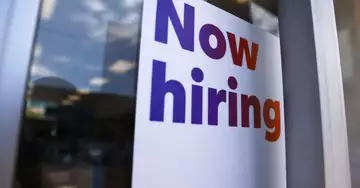The U.S. economy added 428,000 jobs in April, exceeding expectations, according to a Labor Department report released Friday.
Economists had expected a gain of 400,000 nonfarm jobs, according to data from FactSet. The April gain matched the revised 428,000 jobs added reported for March.
The unemployment rate was unchanged at 3.6%.
"Employment growth was widespread and led by gains in leisure and hospitality, manufacturing, and transportation and warehousing," the report says.
The monthly employment summary is closely watched by investment analysts and economists when assessing whether a strong labor market could lead to faster inflation.
Bitcoin and the Fed
Many investors view Bitcoin (BTC) as a hedge against inflation, but the largest cryptocurrency, just like the stock and bond markets, has recently seen a sharp decline in price in response to the Federal Reserve's aggressive actions to curb upward pressure on consumer prices.
The current labor market is considered by many economists to be at full employment, as there were 11.3 million job openings in February, but only 5.4 million people looking for work.
According to the Labor Department report released Friday, average hourly earnings rose 0.3%, up 5.5% from a year earlier.
The additional payrolls, as well as the unemployment rate, are putting pressure on the Federal Reserve as it plans its next steps to lower inflation, which currently stands at 8.5%, the highest level in four decades.
A tighter labor market tends to drive up wages as workers have more options and employers have to pay more to hire or retain them; employers then often try to pass on increased labor costs to consumers in the form of higher prices for goods and services.
Rising labor costs
According to a report released last week, employers paid workers an average of 1.4% more in the first quarter of this year than in the previous three-month period. This was the largest increase in two decades.
The central bank's main job is to keep prices stable and maximize employment, but the current situation in the labor market is increasing inflationary pressures and working against the Fed, which is trying hard to keep prices down while avoiding a recession.
In a press conference Wednesday, Powell called the current labor market "very, very tight" and at an "unhealthy level."
"You can see that the labor market is out of balance," he said. "There aren't enough people to fill the open jobs, and companies can't hire new people, and wages are rising at levels that would be inconsistent with 2% inflation over time."
To get the labor market back to a normal level where supply and demand balance, there needs to be price stability, Powell said.
However, according to a report by economists at BNP Paribas, the imbalance between supply and demand will not diminish anytime soon.
"Even if various price indicators peak in the coming months, labor conditions will largely determine policymakers' inflation assessments," BNP Paribas economists write. "So, in addition to price metrics, labor conditions will ... play an important role in the Fed's interpretation of incoming price data - and we don't see much relief (if any) on that front in the coming months."

